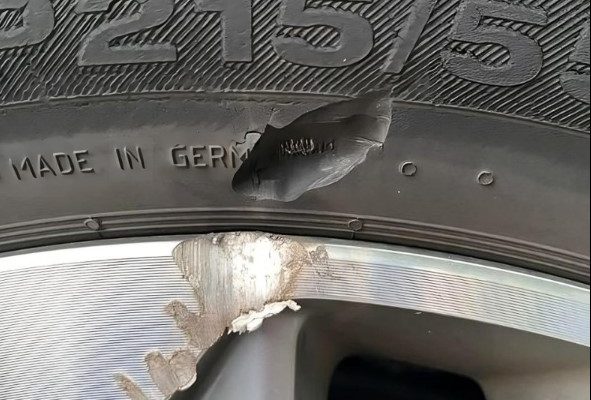You’ve just spotted some damage on your girlfriend’s car—specifically, a noticeable cut on the tire’s sidewall and some scratches on the rim. This might look concerning, but before jumping to conclusions, it’s important to understand the potential causes, the safety risks involved, and the right steps to take. Let’s break down everything from identifying the damage to handling repairs.

Understanding Sidewall Damage: A Serious Safety Hazard
When it comes to tire damage, the sidewall is one of the most vulnerable areas. Unlike the tire tread, which is designed to handle regular road wear, the sidewall is thinner and more prone to cuts, tears, and other forms of damage.
What Causes Sidewall Damage?
Sidewall cuts can occur when the tire scrapes against sharp edges, such as curbs, metal debris, or potholes. Another common cause is driving on underinflated tires, which makes the sidewalls flex excessively, increasing the risk of cuts.
Why Sidewall Damage Is Dangerous
Sidewall damage is not just a cosmetic issue—it directly impacts the tire’s structural integrity. Unlike the tread area, the sidewall cannot be patched or repaired because it bears the brunt of the tire’s flexing and pressure. A compromised sidewall greatly increases the risk of a blowout, which can be extremely dangerous, particularly at high speeds.
If the sidewall damage is deep enough to expose the inner structure, replacing the tire immediately is the safest option.
Understanding Curb Rash on the Rim: What You Need to Know
While sidewall damage is a critical safety issue, curb rash on the rim is often more cosmetic. Curb rash occurs when the wheel scrapes against a curb, causing visible abrasions and scratches.
Why Rims Get Curb Rash
Rim damage often happens during parking or tight turns, especially in narrow streets. Misjudging the distance between the tire and the curb can lead to scraping, which causes the rim to lose its original finish.
Is Curb Rash a Serious Problem?
While curb rash doesn’t pose an immediate safety risk like sidewall cuts, it can still lead to long-term issues. Deep scratches can weaken the wheel’s structure and may even prevent the tire from sealing properly, causing slow leaks.
If the damage is purely surface-level, it can usually be repaired by a professional. However, if the rim is bent or deeply gouged, replacing it might be necessary to ensure safe handling.
Steps to Take When You Spot Tire and Rim Damage
If you notice both sidewall damage and curb rash, it’s important to take action quickly to ensure safety and prevent further damage.
1. Inspect the Tire Thoroughly
Take a close look at the sidewall. If the cut is deep enough to expose cords or metal threads, it’s unsafe to drive. In this case, consider calling a tow service to have the car transported to a tire shop.
2. Check the Tire Pressure
A cut in the sidewall can cause a rapid loss of air pressure. Use a tire pressure gauge to check if the tire is maintaining proper pressure. If it’s significantly low, inflate it temporarily (if possible) and drive slowly to the nearest service center.

3. Examine the Rim’s Condition
Inspect the rim for any deep scratches, dents, or bends. Minor curb rash can be repaired, but deep gouges or structural damage may require replacement to maintain safe driving conditions.
Why Replacing a Tire with Sidewall Damage Is Crucial
Driving on a damaged sidewall is extremely risky, as the tire can no longer maintain pressure safely and may fail unexpectedly.
No Reliable Repairs for Sidewalls
While punctures in the tread can often be patched, sidewall damage is different. The sidewall handles a significant amount of stress, making it unsuitable for repairs. Attempting to patch a sidewall cut compromises safety.
High Risk of Blowouts
A damaged sidewall is prone to blowouts, particularly at highway speeds, where pressure and heat increase rapidly. Blowouts can lead to sudden loss of control, putting the driver and passengers in serious danger.
Replace Immediately
For your safety, a tire with any sidewall damage should be replaced immediately. Delaying replacement increases the risk of an accident, making it a non-negotiable safety issue.
Repairing Curb Rash: Is It Worth It?
If the curb rash on the rim is primarily cosmetic, you have a few options depending on the extent of the damage.
DIY Repair Kits
For minor scratches and abrasions, DIY kits are available. These kits typically include sandpaper, filler, and paint to restore the rim’s finish. While this can improve appearance, it’s not effective for deep gouges.
Professional Rim Repair
For more significant curb rash, professional repair is a better option. Technicians use specialized techniques like sanding, buffing, and repainting to restore the rim’s original look and functionality.
When to Replace the Rim
If the rim has deep gouges, cracks, or bends, replacement is necessary. Driving with a damaged rim can affect handling, cause vibrations, and even damage the new tire.
Could This Damage Indicate a Bigger Issue?
While sidewall damage and curb rash are common, they could signal larger problems that need attention.

1. Driving Habits
If this isn’t the first time you’ve noticed such damage, it might be worth discussing driving habits with your girlfriend. Frequent curb rash and sidewall cuts could indicate a need for more cautious driving, particularly in tight spaces or on rough roads.
2. Alignment and Suspension Problems
Repeated tire damage may be a symptom of misaligned wheels or worn suspension components. It’s a good idea to have the vehicle inspected by a professional to rule out any underlying issues.
3. Parking Locations
Regularly parking in tight spots or along busy streets increases the risk of curb rash and sidewall damage. Opting for safer parking spots can help minimize future damage.
Conclusion: Addressing Tire and Rim Damage for Safety
Spotting tire and rim damage can be concerning, but addressing it promptly ensures the safety of the driver and passengers. Sidewall damage requires immediate tire replacement, as it poses a serious blowout risk. Curb rash, while primarily cosmetic, should also be repaired or replaced if it compromises the rim’s integrity.
Have an open conversation with your girlfriend about the importance of addressing this damage. Whether it’s adjusting driving habits or considering safer parking options, taking proactive steps can prevent future issues and ensure a safer, more enjoyable driving experience. Prioritize safety, stay vigilant, and keep your tires and rims in top condition for the road ahead.



